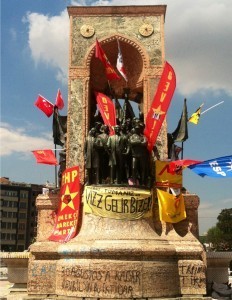Lisa Niver's Blog: We Said Go Travel, page 420
February 16, 2014
Delhi: A peep into the history of India
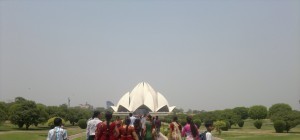 Our Theme- A Place to spend our holiday without any regret.
Our Theme- A Place to spend our holiday without any regret.
My mind whispered New Delhi without any ambiguity. When we think of a ‘must see place’ in India, definitely a glimpse of Delhi will flash through our minds. More than being the current capital city of India, its glory dates back to the period of Mughal Emperors. Better Visit Delhi than just flip the pages of our history book. A single day would be insufficient to snap the entire elegance of monuments and palaces that stood as the remnants of the Mughal dynasty. But we (sorry, forgot to tell. It was with my mom, dad and brother I went for the trip) got only a single day to visit Delhi as a part of our 10 day kulu-manali-shimla hill station tour package from vikram travels.
As It would be ideal to commence our journey with the blessings of god, reached the Birla Mandir- a Hindu Temple dedicated to Lord Laxmi Narayan(Mahavishnu). The temple was built by the famous entrepreneur Birla and inaugurated by Mahatma Gandhi, father of our Nation. An adorable idol of the God Krishna with his love Radha surrounded by entirely mirrored walls was extremely pretty to catch my eye among all the others. A lot more to say about the temple; but if I didn’t stop here, this diary of my experience would become a novel (just joking!!!). Only single line – a place for an eternal bliss.
We then left the temple and reached the Red Fort, a prominent historical place. It was the residential palace of the Mughal rulers. Eagerly awaited to hear the history of the Fort from the lips of the guide. He explained the precious peacock throne of Mughal Emperor Shah-Jahan, the Persian Shah NadirShah who looted the same along with several other treasures such as diamonds. We could see the ‘Diwan-E-Aam’, ‘Diwan-E-Khaz’; the rendezvous for the king and officials for discussing and solving public issues. A cute sight when leaving the place- lot of tiny squirrels making shrill sounds in the trees and the lawn in front of the Fort. An extreme summer climate of around 38 degree Celsius made us very tired. So mere bird’s eye view of the memorials Rajghat, Veerbhoomi, Shantivan; crematory places of our late eminent national leaders. It was a funny fact to hear that a nearby place is already reserved for one of our Ex- Prime Minister.
The diverse nature of India highly supported the peaceful co-existence of peoples with different views in their political, religious and cultural beliefs. That is the reason for the numerous temples, Mosques, Christian churches, Sikh Gurudwaras over here. We next had the visit of famous ‘Bahai Temple’ reknowned as the ‘Lotus Temple’. An enchanting garden led to the ‘Lotus Flower’ shaped mansion. Chappals were not allowed from the way to the temple itself, we walked barefooted and felt like our foot was burning in the hot sun. Unlike other temples, It was like an auditorium which can hold a thousands of people and a stage in the centre. Staffs in charge there imposed the visitors to keep pindrop silence inside. Oh! What a calm and quiet environment for meditation. There were few staffs distributing pamphlets containing information about the Bahai religion and the Temple. Now its almost the noon time we left there and reached the Qutb minar nearby. Qutb Minar- the tallest minar in India, an ancient Islamic monument built by the rulers Qutb- ud- din Aibak and IIltumish, a wonderful structure in red sandstone and marble. Clicked our cameras here and there to keep them safe in our memory cards.
Inside the minar, there was a staircase leading to the top, but the visitors were not allowed to climb following a tragic stampede due to the electricity failure a few years back. A lot of things to keep our mind filled, but the hot humid climate and tiredness emptied our stomach. So had our lunch- a vegetable biriyani and the kerala special yummy vermicelli ‘payasam’ . Our next destination was ‘Teen Murti Bhavan’, Indias’s first Prime Minister Jawaharlal Nehru’s residence now turned Museum. A walk into the 1950’s and 60’s- libray, bedrooms, books etc used by Nehru. Also visited the residence of the only lady Prime Minister of India- Indira Gandhi Museum. She was a bold and beautiful lady, the commander of many reforms in ancient India. But the bad luck! she was shot dead by the revenge from her own body guards. There was in the Museum the blood smeared saree she wore during her last breath. Lot of things more- family photos, gifts, dress items, shawls, knitting accessories etc used by Indiraji. Finally we went to the India Gate, a national monument- a memorial for the lot of Indian soldiers who lost their lives in the First World War. Its foundation stone was laid by His Royal Highness, the Duke of Connaught in 1921. Now there is a garden surrounding the gate where peoples gathered in their evenings. Oh! The sun is going to set; a day is over. But lot of places yet to see- The Taj Mahal, Agra Fort etc. Had a quick shopping in the Karol Bagh Market and reached our inn.
About the author: Suchithra, born in India.More specifically in kerala, the land of backwaters and mountains. Interested to travel and have seen many places in North and South India. Currently working as Engineer in Qatar.
Thank you for reading and commenting. Please enter our next Travel Writing competition and tell your story.
The post Delhi: A peep into the history of India appeared first on We Said Go Travel.
February 15, 2014
Take Me Back to the Forest: Algonquin Park, Canada
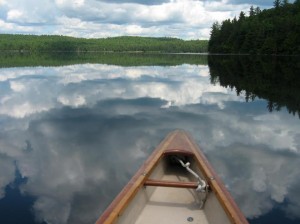 It’s the scent of the place that keeps bringing me back, that lulls and haunts my memory when I am away from it. Miles of densely packed pine trees, woven and stitched together like a thick army: a force like that can’t help but emit not ripples but waves of their earthy perfume, rich and dark. It’s the scent, I think, that reaches out with arms and tugs at all that is wild in me, until I am inside out, raw, with fresh, baby skin, aching to dirty myself in the forest’s floor and absorb its unrefined fragrance.
It’s the scent of the place that keeps bringing me back, that lulls and haunts my memory when I am away from it. Miles of densely packed pine trees, woven and stitched together like a thick army: a force like that can’t help but emit not ripples but waves of their earthy perfume, rich and dark. It’s the scent, I think, that reaches out with arms and tugs at all that is wild in me, until I am inside out, raw, with fresh, baby skin, aching to dirty myself in the forest’s floor and absorb its unrefined fragrance.
It’s a forest floor that is brimming with history, and if you lean your ear down close, you can still hear the whispers. Whole tribes of people who lived, dependent on what the forest could give them: berries, game, fish. Before it became an escape, a National Park in Canada, a vacation destination, it was a way of life. And we return to remember why.
We take a step back in time, in a sense, when we come here. A pilgrimage of sorts, to the way things were. We come with our modern things, yes, our fiberglass canoes and quick-dry shorts, our iodine water tablets and our freeze dried pasta specials. We don’t depend on the forest the way they used to; we have no need to be attentive to the direction the trees sway or the color of the sun when it slides down the sky. The way we live is no longer dependent on the flooding of the lakes, but we are drawn by the whispers. We are drawn by the way we could have been.
And so we flock to this park, in our modern ways, to the doors of forest and lake. We hang our food bags between trees and we ask the forest floor for kindling. We remember what it feels like to have dirt under our nails; with pride, we relish the soreness in our shoulders, knowing it was our strength that transported us across the lake. No phones, no cars, only the odd hum of an airplane, we are stripped of distraction and forced to wade through the hard work of living well, pushing far each day’s folds and smoothing out the creases.
We go back in time in another way, here in this park in the North, where the sun doesn’t set until ten and the stars come close enough to make us wonder if our eyes have turned to magnifying glass. This is the place we go as a family; the place my dad missed only one year out of twenty two, the year he was diagnosed with cancer. When we come back here together, we go back in time, paddling through lake and memory. Remember the spider that made a web across our canoe, and the way it caught the rain when it fell? Remember the moose tracks we found on our site? Remember the loon lullaby out on the lake, the one we still dream about at home? Remember when your gorgeous gray eyes were all I thought I needed, and being back here, on this boat, I think it is true again?
We come back to this place, not because it is whole, for nature is as broken and bruised as the rest of us. We come back to this place because it is real, because it is unspoiled and therefore can wash us clean in its dirt. We come back because the scent of the forest reminds us that this is place is bigger than us, but the whispers wrap around us and make us part of this place.
We come back to this place not because it makes us feel like living, but because it reminds us that we are alive, and our souls stir and whisper like the forest floor.
About the Author: Rachael Dymski is a Masters in Fine Arts candidate at Chatham University in Pittsburgh, Pennsylvania. She travels all over the world, but Algonquin is her favorite place.
Thank you for reading and commenting. Please enter our next Travel Writing competition and tell your story.
The post Take Me Back to the Forest: Algonquin Park, Canada appeared first on We Said Go Travel.
Here in America, What’s Outside Your Window?
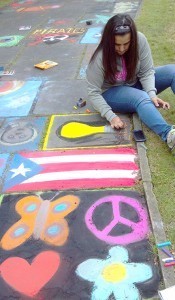 Perhaps it is fitting that we celebrate the beautiful places to travel in America alongside the 50th anniversary of our nation’s War on Poverty. From the hill of an Appalachian farm, to the cellar of an abandoned metropolis, we have all witnessed two Americas in which we live.
Perhaps it is fitting that we celebrate the beautiful places to travel in America alongside the 50th anniversary of our nation’s War on Poverty. From the hill of an Appalachian farm, to the cellar of an abandoned metropolis, we have all witnessed two Americas in which we live.
Yes, we can choose to ignore the other America or we can learn a valuable lesson about our own favored humanity. How lucky are we to be living in a cherished America? Today, we certainly know what glory and honor feels like, don’t we?
Yet, children from that other America grow hungrier for their next meal.
Never mind that they are living across the street, or maybe a few blocks from where we live. Perhaps this is the real lesson we are supposed to learn whenever we think about where we’d rather be.
When you live in Cleveland like me, you are constantly reminded of how the other half lives. Come along on a ride, and drive with me via the Harvard or Hough neighborhood.
Now you will see how blessed you are.
We are no different than our poorest brother in Columbia, South Carolina, or our rural sister in Johnson City, Tennessee. Everywhere you turn, you see the privileged and the poor.
Don’t you?
I witnessed it too, when I started on a journey in mid-December of last year. I traveled to see the flip side of America, logging 3,600 miles, just so I could gain a better understanding of this War of 50 years. From Charleston to Boonville, Sumter to Miami, I saw the privileged and the poor seated side by side.
Just like here in Cleveland.
Over in Orlando, I drove to feed the homeless near Lake Eola Park on Christmas Day. After hundreds stood in line for a meal and a change of clothes, I walked to my car and wept for the family who will never get to see the honor and privilege that I know. This War in America, in all its segregated north and south, has been built by embattled politicos and a lineage that determines whether you and I will end up in a bread line. Why is this? If we think this is the answer, we have no one but ourselves to blame.
In Ocala, the hungry huddle together in a national forest just to survive. They rely on Good Samaritans who remain anonymous, just so the hungry can disappear into the woods with a little food and a warm blanket. Over in Dekalb County, Georgia, why would we ever want to turn a blind eye to the boarded-up homes that mirror our own? This is our two Americas, everywhere you turn.
We all know we should reflect a bit like Dr. Martin Luther King, Jr., who spoke of those very same two Americas. And we can either speak out against such atrocities or risk beating that dreadful drum we have been pounding on for the last five decades.
There are some of us who live in a different world, but don’t believe for a second that you are too privileged to become a part of that other America. Take a look.
It’s just outside your window.
About the Author: Maria Dimengo is a freelance writer and graduate student living in Cleveland, Ohio. She enjoys traveling in the U.S. and learning about people, cultures and neighborhoods.
Thank you for reading and commenting. Please enter our next Travel Writing competition and tell your story.
The post Here in America, What’s Outside Your Window? appeared first on We Said Go Travel.
Blue Like Desire: An excerpt from Love At The Speed Of Email
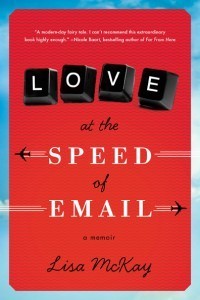 In Love At The Speed Of Email, two humanitarian workers defy the uncertainties of distance and the isolation of working in some of the world’s most remote and challenging corners to build a long distance relationship entirely via email. As they risk love, the narrator struggles to better understand the legacies of her nomadic childhood and find a satisfying answer to that simplest of questions, “where’s home?”
In Love At The Speed Of Email, two humanitarian workers defy the uncertainties of distance and the isolation of working in some of the world’s most remote and challenging corners to build a long distance relationship entirely via email. As they risk love, the narrator struggles to better understand the legacies of her nomadic childhood and find a satisfying answer to that simplest of questions, “where’s home?”
Love At The Speed Of Email recently received an Honorable Mention in the prestigious and competitive Writer’s Digest Self Published Book Awards.
This excerpt is drawn from the first chapter, Spinsters Abroad, and explores an encounter common to many Western travelers…
Blue Like Desire
I was sitting alone at dawn on a cold metal bench in Accra airport, reading, when he sat down beside me.
He was tall – that was the first thing I noticed. Easily six-eight, he towered over everyone else in a room that was already full of tall men. His skin was so shiny black, like oiled coal, that the fluorescent light glanced off him at odd angles. His hair was sectioned and bound into a dozen spiky knobs. He wore spotless red and white Nike exercise gear and sported an enormous square diamond in his left ear. He pulled out a portable DVD player and slid in a disc.
He waited longer than most, four minutes, before striking up a conversation.
“I am Gabriel,” he said. “What is your name?”
I looked up from my book and sighed mentally.
“Lisa.”
“Where are you going?”
“Nairobi.”
“Why?”
“Work.”
“What work?”
“I run workshops on stress, trauma, and resilience for humanitarian relief and development workers.”
I could see that this last sentence didn’t register, and I wasn’t surprised. It usually took some time for native English speakers to fit those pieces together, and Gabriel spoke English with a thick West African-French accent.
“What do you do?” I said, wondering, as always, what was compelling me to ask this.
It’s not that I wasn’t interested in what he did – I was especially curious as to where the diamond came from. It was just that I didn’t particularly want to end up chatting at length to yet another strange man in an airport in Africa. But no matter how many times I tell myself that I’m not responsible for reciprocating interest in situations like these, it breaks all the normal rules of polite behavior to give a one-word answer to a question and return my eyes to my book. Five questions is about my limit. After that I usually buckle and return one.
I learned that Gabriel was a seaman, working cargo ships out of Djibouti. His family was from Cote D’Ivoire but now lived in Ghana. English was his fourth language, and his worst.
“Are you married?” Gabriel asked me. “Do you have a boyfriend?”
This is why I don’t enjoy chatting with men in airports in Africa.
“I have a boyfriend,” I lied shamelessly.
Gabriel did not even pause. This was something I’d noticed with other men, too. Apparently, if my boyfriend was allowing me to wander around Africa unsupervised, I was fair game.
“Do you like to make friends with the black man?” he asked. “I know some white woman; they do not like to make friends with the black man.”
Flummoxed, I tried to think. Answering no was out of the question. Answering yes was tantamount to an open invitation to continue this line of questioning.
I recalled the face of an ex-boyfriend and mentally grafted it onto my hypothetical current boyfriend.
“My boyfriend is black,” I said.
Gabriel smiled. “I like to make friends with the white woman.”
I looked down at my book and turned the page.
I have received more attention from men in Africa than anywhere else in the world. Most of the time, however, I don’t think it’s because of my sparkling personality. How sparkling can you be when you’re travel-weary in an airport, especially when you’re engrossed in a book? But I’m also not deluded enough to think that these propositions come because of any irresistible physical magnetism I am exuding. Most of the time, I get the sense that when these men look at me – my hair, my eyes, even my skin – what they really see is not brown and white but blue.
Blue, the color of my passport. Or, rather, the color of both my passports – the Australian and the Canadian one.
This sometimes bothers me. And the fact that it bothers me bothers me, too.
My parents spent decades trying to teach me that it’s qualities other than beauty that really matter. I’d say I believe that. Why, then, do I catch myself at times like these preferring that someone approach me because he desires me physically than because he desires my citizenship and all the other qualities it represents – escape, freedom, and relative wealth? After all, physical beauty and citizenship are both, to a large extent, assets bestowed on us as accidents of birth. Objectively, citizenship even has some major advantages over beauty – it tends not to depreciate in value over time, and you have to screw up really badly to lose it altogether. Physical assets, however, are subject to degradation caused by any number of things, like gravity, sun damage, neglect, and the overconsumption of ice cream and takeout Chinese food.
“Do you do lots of travel for work?” Gabriel asked me suddenly, interrupting my concentrated study of page 231.
“Yes, lots of travel!” I said, trying to sound busy, mobile, unavailable.
“I travel lots, too, but when I get married I will stay at home with my wife and our children,” he said, clearly hoping I would take the hint and apply for a starring role in that story line immediately.
My strategy during these conversations is to be reserved but polite. Rarely will I be confrontational and firmly shut someone down. Sometimes, however, I will run away.
I dug for the last of my Ghanaian Cedes and headed for the small stall selling bottled water. Then I wandered into the one store in the airport, thinking.
It’s not that I blame the men for trying, I don’t. I even admire their moxie sometimes. It’s more that I hate the way it makes me feel defensive and objectified when I suspect that I’m simply being seen as a walking one-way ticket to wealth and a better life. But why should I feel any less objectified, or any more flattered, by a man looking for a pretty smile and a tight shirt?
“Perhaps,” I thought as I stood alone in the airport on that sultry morning in October, “I’ve been coming at this all wrong. Maybe my parents are right. It is other qualities that matter more than beauty – it’s my passports. Maybe I should start seeing them as just as tangible (and more indestructible) assets than my cup size.”
Behind me a voice called my name.
I turned and looked up. Gabriel had come to find me, to make sure I’d heard that they had called pre-boarding. He pressed a piece of paper containing his phone number and an email address into my hands.
“Where I come from we have a saying” he said, “‘My blood met your blood.’ When I saw you here today, my blood met your blood.” He looked at me meaningfully and paused.
“Then again,” I thought, “maybe I should just invest in a fake wedding ring. Call me demanding, but I need someone to be drawn to my passports, my pretty smile, and my personality.”
I smiled, awkward, and tucked the slip of paper into my bag.
“It was nice meeting you, too.”
Buy Love At The Speed Of Email
$4.99 for Kindle or Nook
$11.66 for a print copy
Lisa McKay, her husband, and their two young sons, currently live in Laos.
The post Blue Like Desire: An excerpt from Love At The Speed Of Email appeared first on We Said Go Travel.
Maratua, Indonesia- I’ve Found My Peace
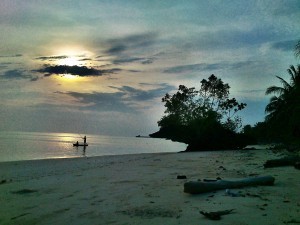 Being an 8 to 5 worker in this young age totally ruined my happiness. I felt very alienated every time I wake up in the morning. Then suddenly an idea came up in my mind. I must go. Then i packed up my things and took my first step outside home. That was 3 years ago when I started my long journey around Indonesia.
Being an 8 to 5 worker in this young age totally ruined my happiness. I felt very alienated every time I wake up in the morning. Then suddenly an idea came up in my mind. I must go. Then i packed up my things and took my first step outside home. That was 3 years ago when I started my long journey around Indonesia.
I kept walking through the exotic places of Indonesia. From the primitive cultures in Papua and Borneo, until the remained civilizations of Dutch colonization. From the top of Mahameru mountain, until the beautiful view of Taka Bonerate atoll. I keep traveling on and still can’t fulfill my search for peace. Until I found this place called Maratua.
Located in northern part of East Borneo, this small remote island offered me everything I’ve been looking for so long. First time I came here all by coincidence. I was in Berau looking for the only train that has ever operated in Borneo from Dutch colonization era. But I was disappointed bacause all of it were thrown down and almost no remains left at all. That was a depressing time for me. Because I spent almost half a year look for it. Then a local there offered me to go to this island.
I was not in the good mood the time I went there. But it changed suddenly once I arrived in this island. Beautiful white sandy beach with clear water, natural rain forest, and hundreds of limestone caves to see. Six months of disappointment payed in a minute. The people still live in a traditional way. Relaxing place with beautiful view.
Wake up in the morning to see the sunrise in front of me. It looks like raising only for me. With all the seagulls dancing on the sky. Waves and breeze bringing joy. A good picture to start a day. Then I go to the beach to see green turtles swim around me. This island is home of thousands of green turtles. One of the biggest species of sea turtles in the world. Swimming a little bit far and I found manta rays swimming around the shallow water to take their food. The sun is high now and a walk to Maratua lake to swim with the stingless jellyfish would be a good option. Here I can find 4 species of jellyfish that has no sting at all.
This is the most beautiful place I’ve ever seen. Besides the nature, the local people here are friendly too. Not only to the people but also to the environment. They keep all the environment as natural as it used to be. I enjoy the conversations with them. They still keep the principal that God, human, and nature are one substance. Therefore we must keep balance between all of them.
Seeing green turtles lay eggs at night is very magnificent for me. Local people help this animal to reach the safe part of the beach to lay eggs. This for me is a lifetime experience I won’t forget forever. Running away from modernization and back to nature. Learning how people interact very friendly with the environment. Not because of the environmentalist campaign, but only by the local wisdom they keep for hundreds of years. In this island called Maratua, I’ve found my peace.
About The Author: Prayuda Said. An Indonesian who enjoys traveling around his country. After 3 years of non-stop traveling, he is now permanently staying in Maratua Island. But still frequently travel to fulfill his dream. Seeing all this 17,504 of island archipelago with his own eyes.
Thank you for reading and commenting. Please enter our next Travel Writing competition and tell your story.
The post Maratua, Indonesia- I’ve Found My Peace appeared first on We Said Go Travel.
February 14, 2014
Tibetans in Bylakuppe: My spiritual haunt
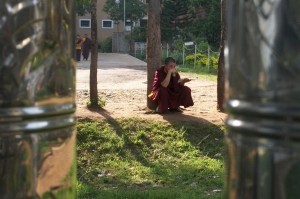 It all started when I overheard a Tibetan girl in my college mention a place and a celebration huge enough to merit the blessings of His Holiness, the Fourteenth Dalai Lama. In love with all things Buddhist, and everything Tibetan, I asked for more information and was told about this refugee centre a few kilometers outside Mysore. Bylakuppa, or Kuppa for short – the second largest Tibetan settlement in India after Dharmashala. It is also where monk-lings come to be trained in the ways of the Nyingma tradition in the reputed Sera Monastery. The same Sera that originally existed in Lhasa and was a sacred place of higher learning and monastic education, until the Chinese came and destroyed its sanctity. A displaced institution, and over ten thousand displaced Tibetan countrymen – this is what Kuppa is, in a nutshell. A home to those, who have lost their own.
It all started when I overheard a Tibetan girl in my college mention a place and a celebration huge enough to merit the blessings of His Holiness, the Fourteenth Dalai Lama. In love with all things Buddhist, and everything Tibetan, I asked for more information and was told about this refugee centre a few kilometers outside Mysore. Bylakuppa, or Kuppa for short – the second largest Tibetan settlement in India after Dharmashala. It is also where monk-lings come to be trained in the ways of the Nyingma tradition in the reputed Sera Monastery. The same Sera that originally existed in Lhasa and was a sacred place of higher learning and monastic education, until the Chinese came and destroyed its sanctity. A displaced institution, and over ten thousand displaced Tibetan countrymen – this is what Kuppa is, in a nutshell. A home to those, who have lost their own.
Three years later and still ruing the lost opportunity of having met the Dalai, I decided to drive down to Kuppa on my maiden bike trip. The pilgrimage beckoned, and as I left smoke filled Bangalore behind at six in the morning, I had a huge smile on my face hiding behind the helmet. The hungry wheels of the Pulsar devoured the tarmac greedily and as the miles receded, each stop on the way added to my impatience. The traffic on the way almost drove me crazy, but when I took the turn away from the clogged roads, my lost smile wanly crept back onto my lips. The polluted skies of the city was left behind and a wide expanse of tree lined road opened up before me. The bike lusted on and I tried to capture the world from behind the screen of my visor. Eucalyptus trees raced by, as did innumerable unnamed ones; each taller and stronger than the other. From behind the tree curtain I glimpsed undulating hills carpeted with green, sometimes with a lonely sentinel keeping guard. And every once a while, the golden canopy of Kuppa’s famous monastery peeped through and excited me with its increasing nearness.
Finally, after taking a small off-road turn again, I entered the protected zone that’s marked ‘only for Tibetans’. The world suddenly turned into a flurry of maroon robes and yellow vests, and a host of rosy cheeked faces. Instantly I felt filled with peace.
I spent three days in Kuppa, taking my time knowing the place. I saw tourists come and go in droves and I wondered at their delight in adding one more destination on their ‘have visited’ list. I, who adds places to my own ‘have known’ list, admired their frugality for they seemed to be so capable of spending such less time in such wonderful places. I could spend hours just looking at the intricate drawings on the walls of the monasteries, and gazing at the serene faces of the Buddhas and yet, be insatiate.
When eve fell on my first night in the temple town, and the monks went about their ritual circumambulation of the shrine, I sat outside and silently acknowledged their devotion. One of them came to me and asked if I would like to know more about the place. I nodded eagerly and surrendered my remaining time in Kuppa to his wisdom and friendliness. From him I learned the correct way to bow to the Buddha, and the words that are spoken while doing so. From him I heard tales of Tibetans in exile, and shared stories I had collected from friends and travelers. He taught me to enjoy Tibetan tea, and to revel in their cuisine. He taught me meaning and importance, and provided me with snippets that I will remember for a lifetime and repeat to all I know.
At the end of the trip, as I said my goodbyes and thanked him for his time, he told me that it was his last day out before he took a vow of silence and entered the meditation chambers for a whole six months; a grueling requisite of his monastic lessons. I immediately began to miss the man and wished to spend some more time with him discovering this culture and this people whom I admired so much. I knew I would not see him again, this monk who had agreed to spend his days teaching a wide eyed ignoramus about himself and his. But I also knew that because of him this small town I had waited three years to visit was now more than just a tourist thing. I felt I knew the place a little better, and that I somehow belonged here among its colorful multitude.
About the Author: Kumari: Happy-go-lucky 20 something who always feels like a two year old. Is a Masters in Science, but works at a travel start-up in Bangalore, India’s start-up hub. Is also a book worm, dog – lover, closet poet, armchair philosopher, and dreamer. Firm believer in the goodness of all things ‘Food’; enjoys visiting kitschy eating places, and wishes to have her own restaurant one day.
Thank you for reading and commenting. Please enter our next Travel Writing competition and tell your story.
The post Tibetans in Bylakuppe: My spiritual haunt appeared first on We Said Go Travel.
Cinque Terre: A Little Bit of Everything
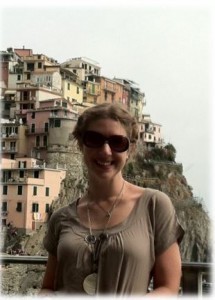 As we traveled around Italy on our honeymoon, one of the places my husband and I planned to visit was Cinque Terre, a collection of five tiny villages along Italy’s west coast. We heard about Cinque Terre from my sister who studied in Italy during college. She loved her visit there and told us we must go. So, after a short time in the Lake Como area, we drove over to the coast.
As we traveled around Italy on our honeymoon, one of the places my husband and I planned to visit was Cinque Terre, a collection of five tiny villages along Italy’s west coast. We heard about Cinque Terre from my sister who studied in Italy during college. She loved her visit there and told us we must go. So, after a short time in the Lake Como area, we drove over to the coast.
What is so interesting about these five villages along the sea is that there are hiking trails linking each one to the next. No car necessary; you simply walk from town to town. If that’s a little too much exertion for you, there is also a train that will take you to all five villages.
We decided to start our Cinque Terre experience in the northern-most village, Monterosso. A very helpful information desk attendant at the train station not only showed us all of the possible places to stay in town, but also called around until she found one with an available room for us! After checking in and unloading, we headed back into the town to grab a bite to eat and watch the full moon rise over the ocean. The night was simply magical as we strolled through town, enjoyed an evening gelato, and walked back to our little hotel.
As a new day began, we packed our belongings, put on our swimsuits under our hiking clothes, and checked out. We weren’t sure where we would end up that day, but we knew we would not be back. We walked through the village of Monterosso on our way to the hiking trail. Monterosso is the largest of the five villages and had plenty of local shops and outdoor markets to meander through on our way out. Finally, we got to the trail and began our hike toward Vernazza.
The hike itself was beautiful and not terribly difficult. We stopped frequently to take pictures of the breathtaking landscape, the fading Monterosso, and the ever-closer Vernazza. You can’t help but want to take pictures of these towns. All of the buildings are painted bright, vibrant colors as they hang onto cliffs and ledges and jut out into the sea. About an hour later, we were in Vernazza. The village center goes right down to the water, which is where we stripped down to our bathing suits and laid out on a large rock to rest and sunbathe before finding some lunch and heading back to the trail.
Another beautiful trek took us to Corniglia. It is the middle village of the five and is quite small. We stopped in a store briefly to get a couple water bottles and then continued on, having high hopes of hiking to all five villages in one day. That is, until we hit a small snag. The regular trail from Corniglia to the next village of Manarola was closed during our visit. It was highly suggested that tourists take the train to Manarola instead of hiking the detour trail. My husband and I scoffed at taking the train. We came here to get the full experience of hiking to all five villages! And so, we naively began following the detour.
This new trail started with what seemed like hours of twelve to eighteen inch tall stone steps. A few of these were no problem, but soon enough each one seemed like its own mountain, and resting frequently was an absolute necessity. Finally, we came out at the highest point we’d need to climb, and the trail starting going horizontally instead of vertically across vineyard after vineyard. When, at last, it seemed like we were coming to a town, we realized we still had to go down just as far as we had come up on the other side…
We lumbered into Manarolo at last and immediately found a place to stay for the night. We were hot, sweaty, and ready to stop walking for the day! So we showered, put on some fresh clothes, and found a nice restaurant nearby to have a well-deserved dinner. I don’t think we slept any better on our entire trip than we did that night!
On our last day in Cinque Terre, we decided that even though we were still tired from our long hike the day before, we couldn’t leave without having walked to the fifth and final village, Riomaggiore. This final hike was really more of a stroll along a paved road with a view of the ocean and an old man playing love songs on his accordion for the passersby. Hand in hand, we ambled slowly along the path taking it all in. It was the perfect way to end our tour of the gorgeous, quaint, and colorful towns of Cinque Terre.
About the Author: Alice Vlasenko lives in New England with her husband and two dogs. She loves traveling and learning new languages as well as cooking, exercising, and creating art.
Thank you for reading and commenting. Please enter our next Travel Writing competition and tell your story.
The post Cinque Terre: A Little Bit of Everything appeared first on We Said Go Travel.
China: Make Good Choices
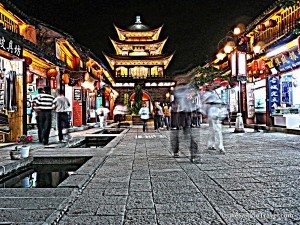 Before I traveled to China, I was worried about so many things. Would I find anything to eat? Would the bathrooms be clean? Would we be able to find the right bus? I had carried a wordless book with colorful images in hopes that when I could not communicate, I could point. On the street our first night in Kunming, I was trying to find out what food some men were cooking.
Before I traveled to China, I was worried about so many things. Would I find anything to eat? Would the bathrooms be clean? Would we be able to find the right bus? I had carried a wordless book with colorful images in hopes that when I could not communicate, I could point. On the street our first night in Kunming, I was trying to find out what food some men were cooking.
“I showed the vendors the animal page with a cow, pig, and sheep and pointed to the kebabs. The man pointed to sheep and said, “Chuggah.” I thought to myself, “Great. We learned a word in Chinese. Chuggah means sheep.” At a mini-mart around the corner, I confidently used the wordless book, pointing to a picture of ice. The lady looked at me and asked, “Chuggah?” I thought, “How odd. Sheep do not look like ice. Sheep and ice are the same word with the tones?” (from Traveling in Sin)
A nice man we met in the store named Jackie explained that “Chuggah” did not mean sheep or ice. It simply meant “This one.” I realized traveling in China would be very different from being an independent traveler in Thailand or New Zealand.
Learning about the history and culture in China was a highlight of our year trip away. I loved staying in a 1000-year-old hotel in Lang Zhong and learning about Chinese New Year. I recently discovered an app that discovers what your Chinese New Year Horoscope is and tells you what vacation spot is a match for you!
The Thomas Cook Chinese New Year Horoscope Finder
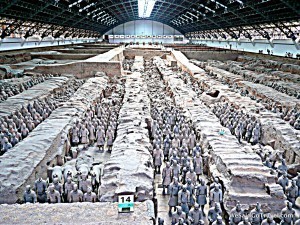 The sights in China were truly amazing. I loved our bus trip to Shilin to see the Stone Forest. After a few weeks, we realized there was so much to see and chose to extend our visa and stay six weeks instead of four. During our travels by bus and boat, we saw many famous sights and UNESCO highlights. I highly recommend you visit this amazing country.
The sights in China were truly amazing. I loved our bus trip to Shilin to see the Stone Forest. After a few weeks, we realized there was so much to see and chose to extend our visa and stay six weeks instead of four. During our travels by bus and boat, we saw many famous sights and UNESCO highlights. I highly recommend you visit this amazing country.
Although at first I was concerned that I would not find food or a way around, I realized that it was possible to travel independently in China. I just had to put in more effort. My whole life I had waited to see Xi’an and the terracotta warriors. The day we visited, I was so excited I was jumping up and down when we saw the first horse. I will never forget seeing all the soldiers and exploring the excavations.
I hope that wherever you dream to travel you make your wish come true this year. As they say at La Rev, “Life is Short. Make Good Choices.”
The post China: Make Good Choices appeared first on We Said Go Travel.
“To Istanbul, Turkey”
I was surprised by the emails and phone calls I had been receiving from friends and family fearing my safety in Istanbul. “Wear a scarf on your head,” they said. “Keep to yourself. Keep your mouth shut,” they wrote. “Tell them you’re from Canada,” they whispered. I was surprised because I’d been there two weeks, and I’d yet to feel fear. I was visiting a country brimming with anger, but the widespread riots were about maintaining a democratic ideal, about feeling threatened by a leader they had trusted, and about maintaining a space where their religious identity didn’t define them, and peace and freedom of expression does.
Turkey is an incredible country, and from the moment I stepped foot in the crowded streets of Istanbul, I was inspired. Turkey is expansive. Turkey is progressive. Turkey has surprised the heck out of me, and I’m a better person having been there during a time of turmoil. Sometimes the most beautiful things can come from the most broken.
Last week, I visited Taksim Square. The night before, I sat on my hotel terrace and smelled the fumes of the burning cars. I felt like a coward in my beautiful hotel, but I told myself it wasn’t my fight. I was an outsider, a tourist. I felt like I didn’t belong, but then I remembered that human rights are everyone’s fight, and after that, I couldn’t stay away. The next afternoon, when I climbed out of the Metro station into the square, I was speechless. The park the people were fighting to protect had been destroyed. There was graffiti everywhere, vandalized and burned vehicles, banners plastered on every building, broken windows, and yet people were happily gathering, talking, sharing food and spreading blankets. Just the day before, people had been arrested, gassed, shot with water cannons, but today the bright sun was shining on the protestors, and there was singing. I heard laughter and chanting, and I watched a man cut a watermelon to share. I walked around for a couple of hours, taking pictures, listening, and watching. I saw a group of college-aged kids painting banners and several people cleaning up a burnt rubbish pile. I saw dancing and yoga. I saw smiling and flag waving, and then I realized that this was the Istanbul everyone else in the world was missing. This wasn’t on the television. My American friends weren’t seeing this part. They were seeing the fear, but they were missing the moments of joy and the celebration, and that was heartbreaking to me. As it grew later, more people were coming to join the protest. It was possible that this night, like the others, could become violent, but the afternoon? It had promise. The afternoon had shown me the resilience of the Turkish people. It showed me that no matter what horrors they endured in the darkness, they would rejoice in the light. I felt honored to be there in that moment. I could feel the spirit and the fight of the people, and it was pretty incredible.
The night before I left, I was enjoying a lovely dinner with my husband in a rooftop restaurant overlooking the Bosphorous. At dusk, the lights of the city across the water lit up like a thousand tiny lanterns. We toasted our last night in Istanbul, and we toasted all that light shining like hope. Today, I am home, but I am still toasting Istanbul. I am still praying for all the voices in Taksim Square. This country has wormed her way into my heart, and truly, I wish I were still there. Despite the turmoil, despite the violence, the country has brought me to my knees. It’s so much bigger than all that anger and fury. It’s a human lesson in perseverance and strength. I’ll raise my glass tonight, and I will raise my glass every night until that fear and violence is replaced with safety and with peace. To Turkey! Şerefe!
About the Author: Jen Lambert is a founding editor of burntdistrict and Spark Wheel Press, and her work has been published in a variety of journals and anthologies including most recently The Los Angeles Review, Boxcar Poetry Review, and Raleigh Review. A fellow at the Virginia Center for Creative Arts, Jen is currently living in Newfoundland with her husband and three wildly beautiful children.
Thank you for reading and commenting. Please enter our next Travel Writing competition and tell your story.
The post “To Istanbul, Turkey” appeared first on We Said Go Travel.
Oh, to be in England!
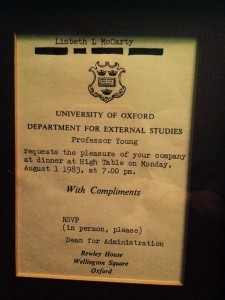 When I saw that my law school offered a program to study during the summer in Oxford, England, I was determined to take advantage of that opportunity. I was fortunate to be attending the University of Oklahoma on a needs-based scholarship, but I was willing to borrow money for my first trip abroad.
When I saw that my law school offered a program to study during the summer in Oxford, England, I was determined to take advantage of that opportunity. I was fortunate to be attending the University of Oklahoma on a needs-based scholarship, but I was willing to borrow money for my first trip abroad.
Despite being jet-lagged upon my July 4, 1983, arrival in Oxford, my senses were invigorated by the carnival-like atmosphere of all the food vendors lining the street. I wondered whether England might be celebrating American Independence Day, which didn’t make a lot of sense, but I would later find out that the food vendors were there every day.
As I walked by one particular seller, he called out to me, “Would you like some Fish’n’chips, Mum?” I was happy to hear him speak in what seemed to me to be a thick, English accent, but I shook my head to indicate no. I was even happier when the vendor responded, “All right then, cheerio.”
Wow! I was in England, and someone had actually used the word “cheerio!” That was the standard word we always used at home when we were imitating British accents. I loved hearing the traditional English word.
Although the vendors were not celebrating anything having to do with the United States, the cooks at Queen’s College (where my colleagues and I were staying) had gone out of their way to provide what they viewed as a proper American dinner in honor of our Fourth of July arrival. Our cafeteria was a vacuous room lined with long, wooden tables and armless, mahogany dining chairs. The windows were covered with thick, velvet drapes pulled together with gold cords. Unlike the buffet style of most American college cafeterias, this dining experience, to be replicated every morning and every night during our stay, came with actual servers. The luxury of it all made us feel like royalty!
The main portion of my first meal in Oxford consisted of a British interpretation of an American hamburger. The burger was sandwiched between two huge sourdough pieces of bread and stood at least half a foot tall. We all laughed as we smashed down the “burger” as much as possible to even form our mouths around it. We saw the servers laughing, too. Perhaps this imitative cuisine was a sly joke on the Americans, a subtle revenge for our successful rebellion so many years ago.
On a raised platform in the area, certain people dined at what was known as “High Table.” Dining at High Table was by invitation only, where several law students would have the privilege of engaging in casual conversation with luminaries from the Oxford world of academia. The program was arranged where each student was invited once to join the High Table.
Academia is quite a different affair in Oxford than in the United States. I was impressed daily as I saw the students walking through town to go “sit for their exams,” as the British expressed it. Such a student did not simply show up in jeans; full regalia was required. This regalia included a gown (such as those worn at graduations in the United States) and caps or hoods.
The summer I visited Oxford was the hottest summer on record there in the past 100 years. Having been told to pack for “sweater weather,” I had to shop for lighter fare. I loved the way the store clerks substituted the word “lovely” for “thank you.” That always made me feel quite lovely, thank you very much.
Oxford is not set up with air conditioning, but one unforeseen benefit of the sweltering heat was that my International Law Professor usually dismissed class early due to the temperature. I was fortunate to be able to long spend weekends exploring parks, art museums, and London.
In London, I visited the crown jewels, and though we tourists were jostled past the display at a rapid clip, the pomp and circumstance related to all the jewelry was undeniable. I also toured Blenheim Palace, the birthplace of Winston Churchill, and marveled at the posh surroundings. In Oxford, I was able to peek into the room of the famous theologian, John Wesley, at Lincoln College.
What I learned from that journey cannot be measured in dollar amounts. I never regretted the money I borrowed to take the trip. In fact, every month after graduation when my student loan bill came due, I was happily reminded of the time I spent in Oxford, England. Even more than thirty years later, my memory of the wonderful summer there still shines as brightly as the Crown Jewels.
About the Author: Lisbeth L. McCarty is a practicing attorney who specializes in criminal appeals. She also enjoys free-lance writing.
Thank you for reading and commenting. Please enter our next Travel Writing competition and tell your story.
The post Oh, to be in England! appeared first on We Said Go Travel.
We Said Go Travel
We Said Go Travel is a global community of over sixteen hundred writers with articles from every continent.
Stories are shared with photos and video from a perspective of the transformative power of travel. We Said Go Travel has hosted live and online events as well as travel writing contests around the world. ...more
- Lisa Niver's profile
- 57 followers


